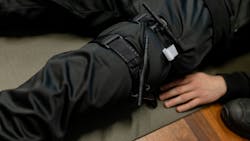There is an age-old debate in Tactical Medicine on what method is better for tourniquet placement: “High and Tight” or 2 to 3 inches above the wound.
As a SWAT Medic and a NAEMT TCCC, TECC, PHTLS Instructor and FLETC Tactical Medical Instructor I would like to dispel the myths. So, let us start at the beginning. A tourniquet is a device that is used to apply pressure to a limb or extremity in order to stop the flow of blood. It may be used in emergencies, in surgery, or in post-operative rehabilitation.
When an agency commits to equipping its deputies with COTCCC grade tourniquets, training should be a significant part of the initiative. Tourniquets (TQs)are simple devices, but formal training is necessary if deputies are expected to use them to their best advantage during an incident.
For tourniquet application, hands on training is the best way to teach the unique idiosyncrasies of today’s modern TQs. Here are a few tips:
Pull, don’t push. Ergonomically it is easier to tighten a tourniquet by pulling the strap than by pushing the strap. There is a simple way to handle the tourniquet so that it will be set up to be pulled, not pushed tight. Just before slipping the tourniquet onto the limb, be sure to grasp the loop, buckle and tail all in one hand with the tail pointed at the person applying the tourniquet. When using a C.A.T., the red tip at the end of the band should be pointing at the person who is applying the tourniquet. This works when performing self-rescue or when applying it to another person.
Tighten up. When practicing tourniquet application on live participants, deputies most often will not tighten the tourniquet completely to avoid discomfort to the training partner. This memory of inadequate tightening can cause a problem when the application of a tourniquet is required during an incident. One way to improve performance is to use rescue manikins and to apply the tourniquets tightly.
When and how to apply a Tourniquet (TQ)
Both methods are correct however, you must use the proper sequence to provide the best care for your patient. The first phase of care in a tactical setting is usually Care under Fire.
In Care Under Fire or “Hasty TQ”
The TQ is placed High and Tight on the wounded extremity or when the bleeding sight is unknown. Why do we place the TQ “High and Tight” The purpose of high and tight placement is to reduce complications from arterial retraction. We also place them “High and Tight” to ensure we have occluded both entrance and exit wounds. There are some in the community that will say placing a TQ “High and Tight “will cause limb damage. This not the case, Tourniquet placement “high and tight” does not cause limb damage 2004, 2012,2018 journal of trauma. Patient neglect can cause issues. If you do not reassess a tourniquet (same as literally any other medical intervention.) then complications occur. Combat zone Tourniquets have been left on as long as 16 hours (Kragh, 2007. Journal of orthopedic trauma) and the limb has not had any adverse effects. Recommendations are still max 2 hrs., but at two hours the bleeding is controlled to the point where the injury can be down staged. Which brings us to our next phase of care.
Tactical Field Care or “Deliberate TQ”
At this stage previously applied tourniquets should be assessed for effectiveness (bleeding has been stopped and distal pulses are absent). If the tourniquet is not effective, tighten the tourniquet and/or apply a second tourniquet side-by-side and proximal to the first one.
Assess for unrecognized hemorrhage and control all sources of bleeding. If not already done, use a CoTCCC-recommended limb tourniquet to control life-threatening external hemorrhage that is anatomically amenable to tourniquet use or for any traumatic amputation. Apply directly to the skin 2-3 inches above the bleeding site. If bleeding is not controlled with the first tourniquet, apply a second tourniquet side-by-side with the first. NOTE: A severe bleeding wound to the thigh frequently requires a SECOND TQ.
If a tourniquet was applied and not needed, the tourniquet should be converted as soon as possible within 2 hours of application and no longer than 6 hours after application.
Tourniquet Conversion
Every effort should be made to convert tourniquets in less than 2 hours if bleeding can be controlled by other means, unless the casualty is in shock, you cannot closely monitor the wound for re-bleeding, or there has been an amputation; however, do not attempt tourniquet conversion if the tourniquet has been on for six or more hours. Also, consider leaving the tourniquet in place if the tactical or medical considerations make transition to other hemorrhage control methods inadvisable.
While the original tourniquet is still in place controlling the bleeding, pack the wound with hemostatic gauze, if available, and hold pressure for three minutes. Then apply a pressure bandage over the dressing, maintaining pressure. Afterwards, slowly release the tourniquet (over at least one minute) while closely observing for bleeding. If the wound packing and pressure bandage do not control the bleeding, retighten the tourniquet or follow the steps to replace the tourniquet if it is above the clothing, like a high and tight tourniquet. In cases where the conversion has failed, it is appropriate to try again within the next two hours, as long as it hasn’t been more than six hours since the original tourniquet was applied.
If the conversion is successful, loosen the tourniquet and move it down to just above the pressure dressing, loose but with no slack in the strap, in case it is needed later, and annotate the time of tourniquet removal.
About the Author
Tom Perroni
Director of Training
Tom Perroni NREMT, EMT-E, EMT-T, EMT-W. Mr. Perroni is the current Owner & Training Director for the Commonwealth Criminal Justice Academy. He has worked as a Contract State Department Medic & Instructor. He is a current Law Enforcement Officer with several years of service. He is a current SWAT / Tactical Medical Instructor. He is a Medical Instructor Trainer in many areas of medicine to include ACLS, PALS, PHTLS, TCCC, Emergency Medical Technician as well as Critical Care medicine. Mr. Perroni has 15 Years CONUS/OCONUS Contract Medic. Deputy Tom Perroni has over 30 years of operational experience in executive protection, law enforcement, SWAT, emergency medical care and other public safety roles. He has been an instructor for various disciplines for over 30 years, 15 of them as a Firearms Instructor.

